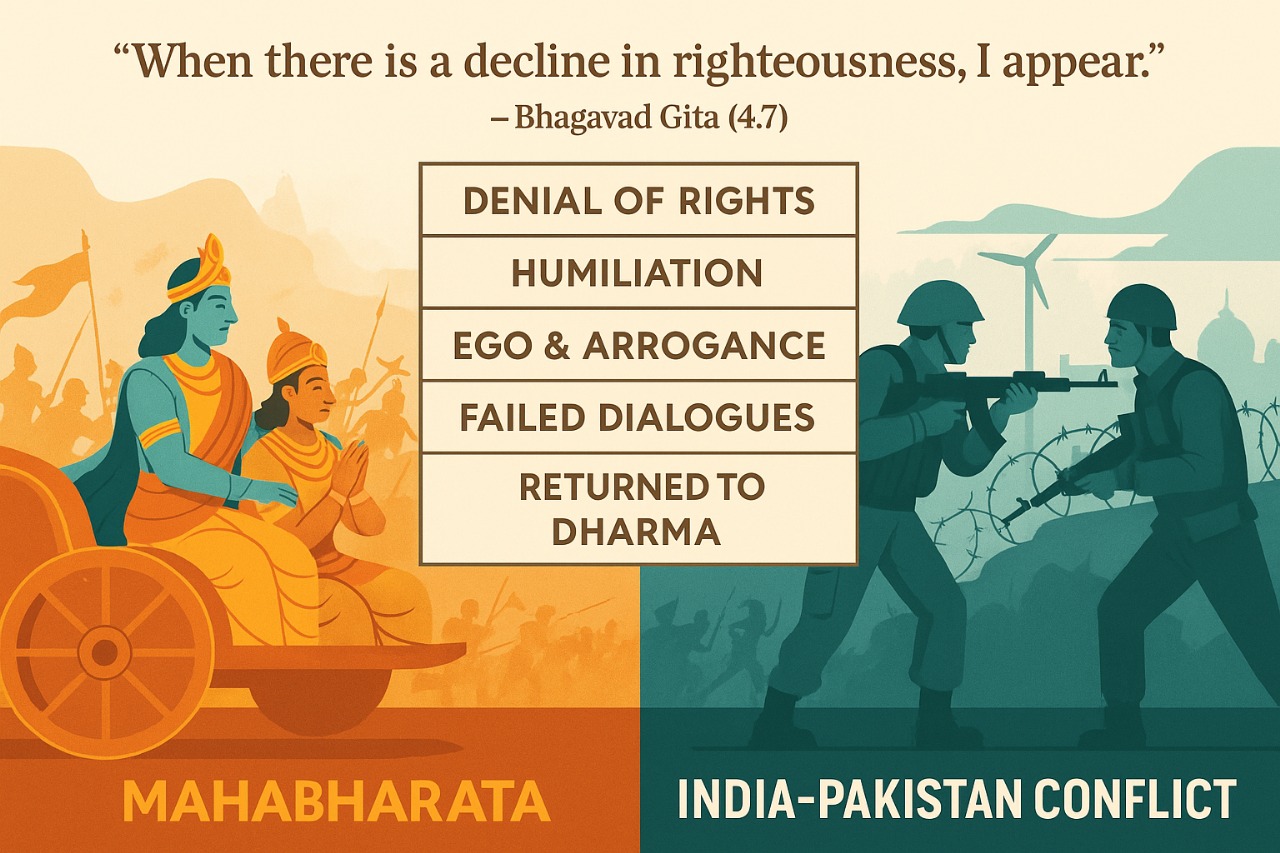India-Pakistan Conflict Through the Lens of the Mahabharata: What History Teaches Us About Repeated Wars

India-Pakistan conflict through Mahabharata’s wisdom
The Mahabharata: An Ancient Blueprint of Conflict
The Mahabharata, an epic of dharma and adharma, teaches that wars are not born overnight. The Pandavas and Kauravas shared lineage, blood, and childhood—yet mistrust, injustice, and ego led to a cataclysmic war.
The key causes of the Mahabharata war were:
- Denial of Rights: The Pandavas were denied their rightful kingdom.
- Insult & Humiliation: Draupadi’s public insult was never forgotten.
- Ego & Arrogance: Duryodhana’s refusal to part with even five villages.
- Failure of Dialogue: Lord Krishna’s peace missions were rejected.
Just like the India-Pakistan conflict, it wasn’t the absence of kinship that triggered war—it was the absence of righteousness and compromise.
India-Pakistan Conflict: A Modern Mahabharata?
Since the Partition in 1947, the India-Pakistan conflict has remained one of the most enduring and volatile rivalries in global geopolitics. Both nations were once one civilization, one culture—yet separated by politics and ideology.
Let’s revisit the timeline briefly (Al Jazeera, Britannica):
- 1947–48: First war over Kashmir. Pakistan captured parts; India retained others.
- 1965 & 1971: Full-scale wars again broke out, culminating in the birth of Bangladesh.
- 1999: Kargil Conflict—echoes of betrayal on sacred ground.
- Post 2000: A long series of ceasefire violations, cross-border terrorism, and nuclear posturing.
The core of the India-Pakistan conflict remains Kashmir—much like Hastinapur in the Mahabharata, a kingdom desired by both but governed by none in peace.
Spiritual Insights: When Is War Justified?
According to Lord Krishna in the Bhagavad Gita, war becomes necessary not for conquest, but when dharma is at risk. A righteous war (Dharma Yuddha) must meet these conditions:
- Exhaust All Peaceful Means: War is the last resort.
- Fight for Dharma, Not Revenge.
- Be Detached From Outcome: Fight with integrity, not hatred.
The India-Pakistan conflict, while geopolitical in nature, must be examined by today’s youth through the lens of these eternal principles: What are we fighting for—security or supremacy? Are we seeking justice or revenge?
Recent Escalations & Their Lessons
In 2025, fresh tensions flared after a deadly attack in Pahalgam, Kashmir. India launched “Operation Sindoor” in retaliation. In response, Pakistan suspended bilateral water-sharing treaties and heightened military readiness.
As history repeats, the India-Pakistan conflict continues to spiral into a familiar cycle of attack, blame, and retaliation—just like the many failed truces between the Pandavas and Kauravas.
This unending chain is not about territory anymore—it’s about trauma, mistrust, and a failure to understand the cost of blood.
What Today’s Youth Can Learn
As a spiritual monk, I say this with firm conviction: peace will never come merely from treaties or defense budgets. True peace comes from alignment with dharma, and that begins with understanding and living the timeless teachings of the Bhagavad Gita.
Here are the key lessons:
- Dialogue Is Dharma:
Even Lord Krishna attempted peaceful negotiations with the Kauravas before war became inevitable. We must prioritize open-hearted dialogue—not just political, but spiritual. - Take Shelter of the Bhagavad Gita:
Duryodhana rejected Krishna’s divine counsel. Arjuna surrendered and sought Krishna’s guidance. The one who rejected wisdom perished in ego. The one who followed dharma was protected, even in battle.
If the leaders and citizens of both India and Pakistan take shelter of the Bhagavad Gita, and truly follow Krishna’s instructions of detachment, forgiveness, humility, and service, only then can lasting peace emerge. - Peace Is Power:
Hatred is heavy. The youth must not carry the burden of historical vengeance. Instead, rise above and choose peace—not weakness, but spiritual strength. - Know the Real Enemy:
It is not another nation, religion, or people—it is anger, pride, greed, and envy. As Krishna says in the Gita (16.21), these are the gates to hell. - Honor Shared Spiritual Roots:
Before borders, we shared saints, rivers, languages, and the divine culture of devotion. Reuniting with this deeper identity can heal our divided present.
“A person who is not disturbed by happiness and distress and is steady in both is certainly eligible for liberation.” – Bhagavad Gita 2.15
The India-Pakistan conflict will never be resolved through guns and retaliation alone. It will be resolved when hearts surrender to the higher truth—when youth rise not to fight, but to follow Krishna’s eternal wisdom, just as Arjuna did on the battlefield.
Summary: The Mahabharata’s Warning to the India-Pakistan Conflict
The India-Pakistan conflict, much like the Mahabharata war, is not just a political battle—it is a spiritual crisis. Both were avoidable. Both were escalated by ego. Both remind us that when dialogue dies, dharma dies with it.
Let us not be the Kauravas of today—blinded by pride, deaf to reason.
Let us be the Arjunas—fearless, righteous, but committed first and foremost to peace.
“Yada yada hi dharmasya glanir bhavati Bharata, abhyutthanam adharmasya tadatmanam srjamy aham.”
– Bhagavad Gita 4.7
(Whenever righteousness declines and unrighteousness rises, I manifest to restore balance.)
May we not wait for divine intervention. May we become the restorers of peace.
📲 Connect with the Speaker for More Insights
🌐 YouTube: Madan Sundar Das Official
📸 Instagram: @madansundardasofficial
💼 LinkedIn: Madan Sundar Das
Let’s make this Akshaya Tritiya truly auspicious by dedicating it to Krishna and His devotees.
Also read :The Bhagavad Gita Overview







Responses